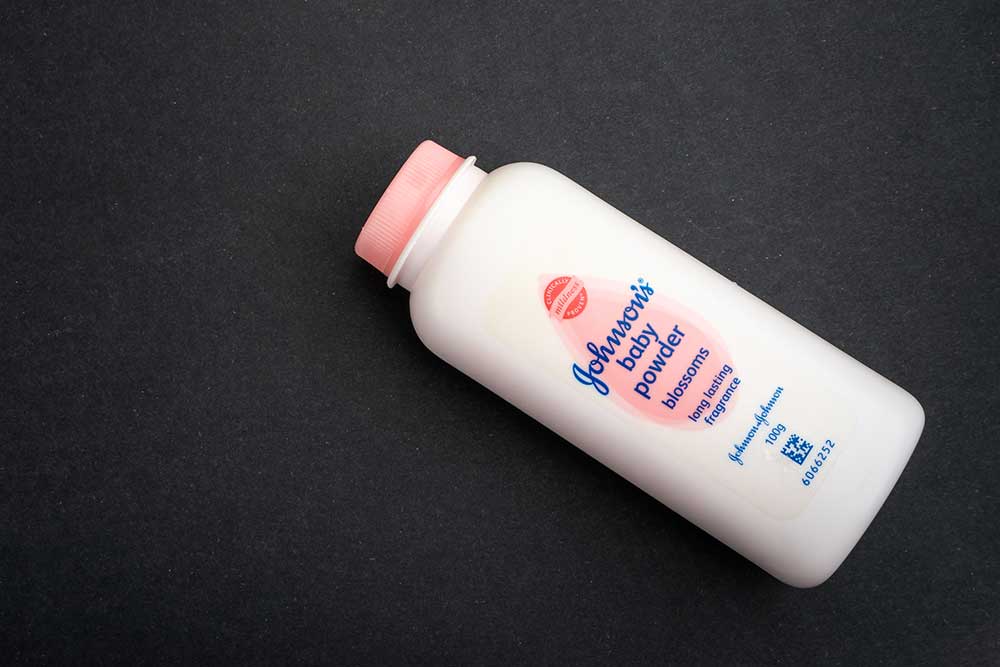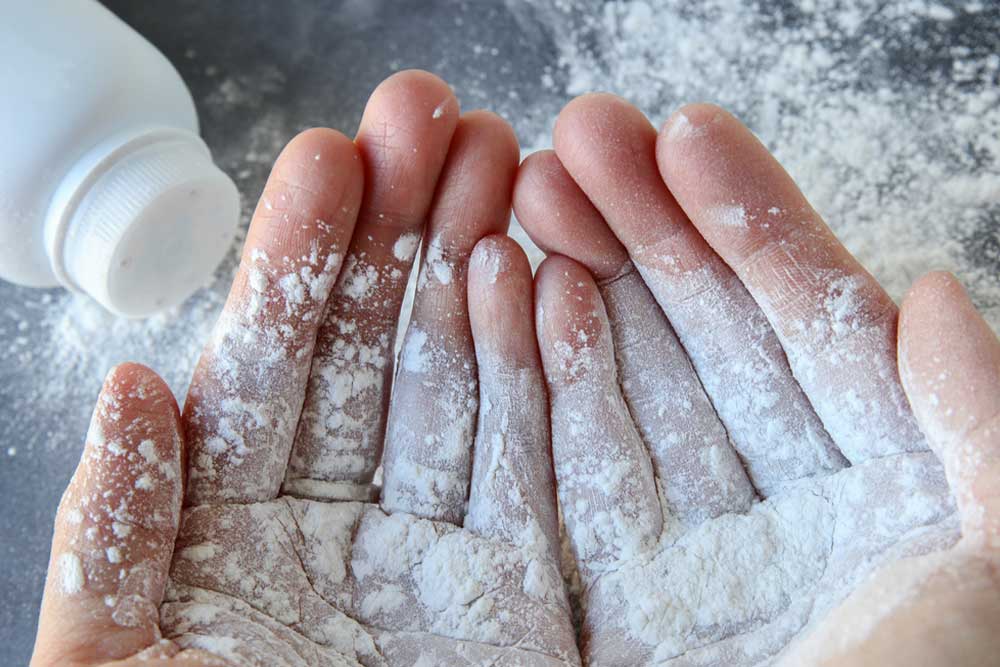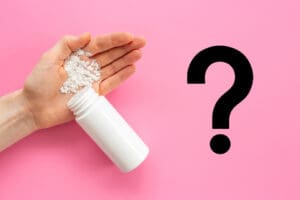While baby powder is known to be more commonly used among infants to absorb moisture and prevent diaper rash, adult men and women often use this as well to soothe friction in the genital area.
Regardless of who uses it, baby powder remains a standard item in many households. But over the years, discoveries have been made regarding the hazards of talcum, the main ingredient in many baby powder brands. So for people who use baby powders a lot, having a potentially dangerous product easily accessible at home can be pretty alarming.
Because of the dangers of talcum found in many baby powder brands, tens of thousands of lawsuits have already been filed against several manufacturers of talcum powder products, the biggest of which is American multinational healthcare company, Johnson & Johnson.
According to the complainants, J&J failed to disclose the presence of talcum in their baby powder products and continued to insist that they were safe, despite knowing the dangers and health risks that may arise due to their continued use.
With the complexity of the talcum powder lawsuits, it can be pretty challenging to keep track of the facts of the case. So what exactly went down, and how did the talcum powder lawsuits start?
How the J&J Talcum Powder Lawsuit Started

Before going into the technicalities of the talcum powder lawsuits, knowing the beginnings of the controversial Johnson & Johnson baby powder and the background of its equally controversial manufacturer should give an idea of how and where things went wrong.
What’s Inside the J&J Baby Powder?
The main ingredient in J&J’s baby powder is talc, also known as talcum powder. On their website, J&J describes talc as a “naturally occurring mineral that is highly stable, chemically inert, and odorless.” The Food and Drug Administration (FDA) also explains that talc is “mined from the earth, composed of magnesium, silicon, oxygen, and hydrogen.”
Aside from baby powders, talcum can also be found in other cosmetic products like face and body powders, antiperspirants, toothpaste, soaps, drug tablets, paint, and even chewing gums.
According to J&J, talcum powder has been tested and proven safe by many studies and research conducted by medical experts across the globe. They also said that science and several clinical evidence have shown talcum powder “is accepted as safe for use in cosmetic and personal care products throughout the world.”
The 2018 Reuters Investigative Report
But despite J&J’s claims that there is nothing to be concerned about their baby powder even with the presence of talc, one explosive report explained in detail the company’s conscious ignorance of the dangers found in one of their most iconic products.
In December 2018, Reuters released an in-depth investigative report detailing how J&J deliberately kept the FDA and the general public in the dark about their asbestos-contaminated talcum powder. The report also examined never before seen documents such as company memos, internal reports, and other confidential papers showing that J&J was aware their baby powder contained asbestos yet did nothing about it.
According to the report, “J&J didn’t tell the FDA that at least three tests by three different labs from 1972 and 1975 had found asbestos in its talc — in one case at levels reported as ‘rather high.’” The report also found that J&J even assured health regulators over and over again “that no asbestos was detected in any sample” of their baby powder products.
J&J not finding any trace of asbestos in their baby powder can be attributed to a significantly small sample size used in their internal tests and the limitations of their testing methods “that allow trace contaminants to go undetected.”
The Link Between Asbestos and Talc
According to the National Cancer Institute, asbestos has been confirmed as a human carcinogen by the US Department of Health and Human Services, the US Environmental Protection Agency, and the International Agency for Research on Cancer — the World Health Organization’s cancer research arm.
J&J is known to take great pride in the “high purity” of the cosmetic talc they use in their baby powder. However, in its purest form, talcum powder usually contains asbestos.
Moreover, asbestos-like talcum powder — is also a naturally occurring mineral. And because these two minerals are typically found near each other in many talc mining sites, it makes talcum powder highly susceptible to asbestos contamination.
The Most Common Illnesses Linked to Talcum Exposure
Testicular cancer, lung cancer, uterine cancer, talcosis, pneumonia, asthma — these are just some of the diseases linked to talcum baby powder exposure. But in the tens of thousands of talcum powder lawsuits that have been filed through the years, two cancer types seem to be the most prevalent among the plaintiffs: ovarian cancer and mesothelioma.
Ovarian Cancer
Ovarian cancer is a fatal cancer type that can develop in the female reproductive system. According to the Center for Disease Control and Prevention (CDC), ovarian cancer is a “group of diseases that originates in the ovaries, or in the related areas of the fallopian tubes and the peritoneum.”
In many of the talcum baby powder lawsuits, female plaintiffs have claimed that they developed ovarian cancer due to talcum powder exposure. Most female plaintiffs have been using J&J’s baby powder for years — either for their babies or in their genital areas — and they believe their continued use of J&J’s talcum powder products led them to be diagnosed with ovarian cancer.
According to consumer advocacy organization Drugwatch, when J&J’s powder is often used in the genital area as part of a frequent feminine hygiene routine, the tiny talc particles can easily “travel through the vagina, uterus, and fallopian tubes to the ovaries.”
Once those talc particles have settled in the ovaries, they can stay there for a long time and may take years before they are dissolved. This can cause chronic inflammation of the ovaries and creates a favorable condition for cancerous tumors to develop over time.
Several studies have been conducted to establish the link between talcum powder and ovarian cancer through the years. But while they all showed varying degrees of ovarian cancer risk after talcum powder exposure, the studies say one thing: the popular Johnson & Johnson baby powder increases the risk of ovarian cancer.
Here is what some of those studies say:
- Cancer Prevention Research Study (2013) – According to a study by this prominent cancer research journal, there is “an increased risk of ovarian cancer between 20 and 30 percent for women who used talcum powder for intimate personal hygiene.”
- The Cramer Study (2016) – Led by Harvard epidemiologist Dr. Daniel Cramer, the study found that “women who used talcum powder on their genitals and sanitary pads on a regular basis were at more than three times the risk” of developing ovarian cancer.
- The Schildkraut Study (2016) – In this study by Joellen M. Schildkraut that examined African American women, it found that those “who use talcum powder in their groin area have a 44% increased risk for ovarian cancer.”
- Tisch Cancer Institute of Mount Sinai Hospital (2017) – In this study, it was reported that although there is a weak link, there is a “statistically significant association between genital use of talc and ovarian cancer.”
- Ovarian Cancer Cohort Consortium (2020) – According to their analysis, the OC3 reported that “use of talcum powder on genitals is associated with a 24% increased risk of ovarian cancer.”
Other Talc Based Powders and Products Linked to Ovarian Cancer
Aside from J&J’s baby powder, Drugwatch also lists other talc-based products implicated in the ovarian cancer lawsuits. These include the following:
- J&J’s Shower to Shower
- Gold Bond Body Powder
- Gold Bond Extra Strength Body Powder
- Gold Bond No Mess Powder Spray
Symptoms of Ovarian Cancer
The American Cancer Society lists the following as the most common and persistent signs and symptoms of ovarian cancer:
- Urinary symptoms such as urgency (constantly feeling like you have to go) or frequency (having to go often)
- Pelvic or abdominal (belly) pain
- Trouble eating or feeling full quickly
- Bloating
- Abdominal (belly) swelling with weight loss
- Changes in a woman’s period, such as heavier bleeding than normal or irregular bleeding
- Pain during sex
- Upset stomach
- Fatigue (extreme tiredness)
- Constipation
- Back pain
Mesothelioma
According to The Mesothelioma Center, mesothelioma is a “malignant tumor caused by inhaled asbestos fibers and forms in the lining of the lungs, abdomen, or heart.” For people diagnosed with this deadly illness, life expectancy is about 12 months at most after diagnosis.
The most common symptoms of mesothelioma include shortness of breath, respiratory complications, dry cough, chest or abdominal pain, pleural effusion (fluid around the lungs), fever or night sweats, weakness in the muscles, and fatigue.
The Mesothelioma Center explains how asbestos affects humans and eventually causes the development of mesothelioma. On their website, they show how mesothelioma progresses in the body.
- A person inhales or swallows microscopic airborne asbestos fibers.
- The asbestos fibers then become lodged in the lining of the lungs, abdomen, or heart.
- Embedded fibers damage mesothelial cells and cause inflammation.
- Over time, tumors form on the damaged mesothelium, leading to mesothelioma.
But mesothelioma does not develop overnight. According to Drugwatch, mesothelioma is usually diagnosed 20-50 years after exposure to asbestos-contaminated talc. And because symptoms do not show straight away, it can be difficult to diagnose until it is already too late.
Because mesothelioma is mainly caused by asbestos, it became another common illness linked to the long-term use of J&J baby powder, which was alleged to contain dangerous amounts of asbestos.
Studies conducted to establish the link between mesothelioma and J&J’s baby powder have yielded varying results. Some of them showed traces of asbestos in the talc used by J&J in their baby powder, but other studies found otherwise.
Regardless of the contradicting findings, a significant number of plaintiffs still claimed that their mesothelioma diagnosis resulted from their exposure to J&J’s powder over the years.
#WeAreTheMany
Who Can File a Talc Powder Lawsuit?

Most plaintiffs who filed talcum powder lawsuits have been diagnosed with ovarian cancer, mesothelioma, or a similar cancer type linked to talc powder exposure. The majority were also exposed to talc powder because J&J’S baby powder products have been a staple in their feminine hygiene routine for years.
So who are the individuals eligible to file a talc powder lawsuit?
- Anyone who had been exposed to and has used J&J’s baby powder and other talc-based products on their genital area and other body parts for more than four years
- Anyone who is officially diagnosed with ovarian cancer, mesothelioma, or other similar cancer types due to known and confirmed talc powder exposure and currently undergoing treatment/medication
- Anyone who is officially diagnosed with ovarian cancer, mesothelioma, or other similar cancer types due to known and confirmed talc powder exposure but has not been required to undergo treatment/medication
- Anyone who has been diagnosed with ovarian cancer, mesothelioma, or other similar cancer types in 2009 or later
- Anyone who has used talc powder before menopause
- Anyone who lost a loved one to ovarian cancer, mesothelioma, or other similar cancer types due to known and confirmed talc powder exposure
J&J’s Handling of the Talcum Powder Lawsuits

Despite the endless talcum powder lawsuits and allegations highlighting their alleged negligence, irresponsibility, and unethical practices, J&J maintains that their popular talc-based baby powder is safe.
Denial of the Health Risks
Their baby powder may have already been discontinued in the United States and Canada, but J&J maintains that their widely used talc powder is safe and does not cause cancer.
In a May 2020 announcement, J&J said that they remain “steadfastly confident in the safety of talc-based Johnson’s Baby Powder” and that the safety of their most popular product is backed by “decades of scientific studies by medical experts around the world.”
J&J also added that they “will continue to vigorously defend the product, its safety, and the unfounded allegations against it and the company in the courtroom.”
J&J Baby Powder Voluntary Recall
In October 2019, J&J announced that they would recall 33,000 bottles of their baby powder distributed in North America after the FDA found traces of asbestos in samples taken from a single bottle included in that batch.
Here is precisely what J&J had to say about the recall, taken directly from their official website:
“Out of an abundance of caution, Johnson & Johnson Consumer Inc. (JJCI) announced that it is initiating a voluntary recall in the United States of a single lot of its Johnson’s Baby Powder in response to a US Food and Drug Administration (FDA) test indicating the presence of sub-trace levels of chrysotile asbestos contamination (no greater than 0.00002%) in samples from a single bottle purchased from an online retailer. Despite the low levels reported and in full cooperation and collaboration with the FDA, JJCI is initiating this voluntary recall of Lot #22318RB of Johnson’s Baby Powder, from which the tested sample was taken.”
“In parallel, JJCI has immediately initiated a rigorous, thorough investigation into this matter, and is working with the FDA to determine the integrity of the tested sample, and the validity of the test results. At this early stage of the investigation, JJCI:
- Cannot confirm if cross-contamination of the sample caused a false positive.
- Cannot confirm whether the sample was taken from a bottle with an intact seal or whether the sample was prepared in a controlled environment.
- Cannot confirm whether the tested product is authentic or counterfeit.”
“JJCI has a rigorous testing standard in place to ensure its cosmetic talc is safe and years of testing, including the FDA’s own testing on prior occasions–and as recently as last month — found no asbestos. Thousands of tests over the past 40 years repeatedly confirm that our consumer talc products do not contain asbestos. Our talc comes from ore sources confirmed to meet our stringent specifications that exceed industry standards. Not only do we and our suppliers routinely test to ensure our talc does not contain asbestos, our talc has also been tested and confirmed to be asbestos-free by a range of independent laboratories, universities, and global health authorities.”
Project Plato: the Creation of LTL Management and the Planned Bankruptcy Filing
But even though J&J continued to slam claims of their baby powder being unsafe to use, their establishment of subsidiary LTL Management at the height of the ongoing talc litigation was seen by many as a desperate and offensive move to evade accountability and dodge the mounting legal costs.
In a press release, J&J said they created LTL Management “to hold and manage claims in the cosmetic talc litigation.” As for LTL’S bankruptcy protection filing, J&J said it is “intended to resolve all claims related to cosmetic talc in a manner that is equitable to all parties, including any current and future claimants.”
With a new subsidiary in place, J&J split its assets from its liabilities. And with bankruptcy protection in place and bankruptcy proceedings expected in the following months, this means that all the ongoing talcum powder lawsuits against J&J need to be temporarily stopped while LTL awaits its bankruptcy decision.
Before the bankruptcy filing, the Supreme Court had already denied J&J’s request to stop a Mississippi class-action lawsuit against its talc-containing products. However, that still did not stop J&J and LTL from filing for Voluntary Chapter 11.
Many cancer plaintiffs consider J&J’s controversial legal move, now infamously called the Texas Two-Step, as an attempt to delay and prevent their cases from ever going to trial. In a recently published special report, Reuters revealed that the creation of LTL and its immediate bankruptcy filing are all part of J&J’s secret plan — dubbed as Project Plato — to “redirect cancer plaintiffs out of trial and into bankruptcy process.”
In J&J’s defense, LTL Management President Robert Wuesthoff said in the jury trials that “most of the cancer plaintiffs would be better off resolving their claims in a bankruptcy settlement than hoping to join the ‘select few’ who won ‘lottery-sized awards.’”
The Talcum Powder Verdicts So Far

Judith Winkel v. Colgate-Palmolive (May 2015) – Winkel claimed that Colgate-Palmolive’s Cashmere Bouquet talcum powder caused her mesothelioma after using the product from 1961 until 1976. The jury awarded her $13 million, but before they could decide on the amount of additional punitive damages, her case was settled for an undisclosed amount.
Jacqueline Fox v. Johnson & Johnson (February 2016) – Fox was the first-ever female complainant to achieve a favorable ovarian cancer verdict against J&J. After using J&J’s talcum products religiously for 35 years, Fox was eventually diagnosed with ovarian cancer and died in October 2015. Four months later, a St. Louis jury awarded her $72 million. But in October 2017, this decision was reversed by the Missouri Court of Appeals.
Deborah Giannecchini v. Johnson & Johnson (October 2016) – Giannecchini had been using the Johnson & Johnson talcum powder on her genitals for about 40 years. As a result, she developed ovarian cancer and was diagnosed in 2016 to have an 80% chance of dying in the next two years. Fortunately for Giannecchini, the jury ruled in favor of her and awarded her roughly $70 million and an additional $2 million paid by codefendant Imerys, one of J&J’s major talc suppliers.
Philip Depoian v. Whittaker, Clark & Daniels (October 2016) – Depoian used to frequent the barbershop his father worked at and claimed that his mesothelioma diagnosis resulted from inhaling talc particles asbestos exposure from talcum powders in his father’s workplace. A Los Angeles jury eventually ruled in favor of him and awarded him $18 million to be paid by talc supplier Whittaker, Clark & Daniels.
Lois Slemp v. Johnson & Johnson (May 2017) – Slemp alleged that her ovarian cancer is caused by J&J’s talcum powder products that she had been using for over 40 years. A St. Louis jury awarded her a total of $110 million in compensatory and punitive damages, but the ruling was reversed in October 2019.
Eva Echeverria v. Johnson & Johnson (August 2017) – Echeverria claimed that her continued talcum powder use for over 40 years caused her to develop ovarian cancer. A California jury ruled in favor of her, and she was awarded $417 million, but she died shortly after, the following month after she won her case. In 2017, the verdict was overturned.
Richard Booker v. Imerys Talc America (December 2017) – Booker sued talc supplier Imerys alongside Dexter Midland Chemical Co., Walter N. Boysen Co., and Vanderbilt Minerals after he was diagnosed with mesothelioma as a result of his constant exposure to asbestos-contaminated talc found in the paint he was making when he was still working for Dexter Midland and Boysen. Booker died in 2016, but a California jury only awarded him over $22 million in damages about a year after his death.
Stephen Lanzo III v. Johnson & Johnson (April 2018) – Lanzo III sued J&J and its talc supplier Imerys after he developed mesothelioma from constant use of J&J’s baby powder and Shower to Shower for years. A New Jersey jury eventually awarded Lanzo III $117 million in damages, but this verdict was later overturned in April 2021 to rule in favor of J&J.
Missouri class action lawsuit (July 2018) – Twenty-two women were behind this landmark class-action lawsuit. They all claimed that J&J’s asbestos-contaminated talcum baby powder had caused them to develop ovarian cancer. In total, a St. Louis jury awarded them a whopping $4.69 billion in damages. J&J appealed the ruling, but the decision was not reversed, and the initial verdict was upheld.
Douglas Barden et al. v. Johnson & Johnson (September 2019) – Plaintiffs Douglas Barden, Will Ronning, D’Angela Mcneill-George, and David Etheridge claimed that they got mesothelioma after they ingested asbestos and talc particles from using the Johnson & Johnson talcum powder. A New Jersey jury awarded them $37.2 million in compensatory damages and an additional $750 million in punitive damages.
Christina Prudencio v. Johnson & Johnson (August 2021) – Plaintiff claimed that her long-term J&J talcum powder use led to her mesothelioma diagnosis. A California jury eventually awarded her $26.5 million and an additional $100,000 million in punitive damages.
Talcum Powder Lawsuit Settlement Amounts

There is no fixed talcum powder lawsuit settlement amount that each plaintiff is guaranteed to get because every talcum powder case is unique. Several factors such as age, overall health conditions before and after the cancer diagnosis, and provable frequency of talcum powder use and exposure all come into play. They will affect how much a talcum powder victim will receive.
Moreover, the terms of the settlement agreements between J&J and the plaintiffs are rarely made public and always confidential, so it is likely impossible to determine how much each settlement costs.
Some talcum powder cases are also part of a talcum powder class action lawsuit in multidistrict litigation (MDL). Cases included in this are not settled individually and equally, so it would be difficult to put an exact dollar figure for each talcum powder settlement.
J&J previously announced that it would be paying $100 million to settle a group of 1,000 cases which works out to $100,000 per case. But because of the confidential nature of settlements, this amount is speculative at best as there is no way to be confident how much an individual talcum powder settlement will cost.
Factors That Affect the Talcum Powder Lawsuit Settlement Amount
No two talcum powder lawsuits are the same. Some plaintiffs may have it worse than others, depending on how bad their condition got after their continued talcum powder use. Several factors can also influence a talcum powder settlement, so getting exact figures for your losses can be challenging.
However, some factors are more common than others, so while each talcum powder case is unique, the following factors will always affect the settlement amount.
- Previous, ongoing, and future medical costs
Plaintiffs exposed to any talc-containing product may be eligible to recover the costs of past, present, and even expected future medical bills related to their cancer diagnosis. In addition, severe and long-term physical, mental, and emotional suffering often translate to higher hospitalization costs, so a talc lawsuit that involves these kinds of suffering will undoubtedly take more time and cost more.
- Lost income
Suffering from cancer after exposure to talc-based products can render the talc powder lawsuit plaintiffs useless for a long time after their diagnosis. Even if they managed to fully recover and overcome cancer, there is a chance that they may not be able to work in the same capacity again, or worse, become unable to do anything at all because their diagnosis left them completely disabled.
- Pain and suffering damages
As far as talcum powder lawsuits are concerned, damages are not only physical and financial. While not quantifiable in bills and receipts, mental and emotional suffering can be just as painful and stressful.
The trauma a cancer patient will endure long after their diagnosis can be as lasting as the physical deterioration they will experience due to the deadly disease. And since there is no way to determine how much a person’s pain and suffering cost, these kinds of damages will significantly vary for each talcum powder lawsuit plaintiff.
- Loss of joy of living
Suppose the cancer diagnosis leaves a talcum powder plaintiff permanently disabled and unable to enjoy life the way they did before they got the disease. In that case, they can pursue damages to compensate for cancer’s impact on their life. While no amount could ever make up for a life-long disability, the justice system can work to provide some monetary respite.
Settlement vs. Trial
Assigning value to a talcum powder case means projecting how much the jury will award and how much J&J is willing to pay. It also means identifying the settlement amount the plaintiffs are willing to accept should they decide to resolve the case outside of the court.
Two major factors come into play when valuing the settlement amount of a talcum powder case: the extent of the plaintiff’s damages and the extent of J&J’s liability.
However, if a plaintiff cannot provide substantial evidence to establish J&J’s fault, their talcum powder litigation settlement amount could significantly decrease even if they have tremendously suffered from cancer as a result of continued talcum powder use through the years.
Should that be the case, J&J might be more inclined to contest their liability in court instead of settling. The plaintiffs may find it challenging to negotiate for higher settlement compensation payouts.
For the same reason, many plaintiffs are more likely to accept a lower settlement amount because of the risk of not getting anything at trial.
Why the Talcum Powder Lawsuit Settlements Can Be Ideal
Talcum powder settlements may not always be the best course of action for every talcum powder lawsuit, but there are a few reasons why they can be more beneficial than trials.
- Guaranteed payout
In a talc powder lawsuit settlement, the compensation is guaranteed once both the plaintiffs and the defendant J&J agree on the terms. After all, nothing ensures recovery than being able to support it financially.
With legal intervention and involvement of the federal court, the amount the talc powder lawsuit plaintiffs will receive may not be as high as anticipated. And while most of the talcum powder cases have generally had favorable outcomes so far, engaging a multibillion-dollar company like J&J in a legal battle is usually more of a financial burden to the plaintiffs than the business they are going against.
- Avoiding the additional financial burden
Talcum powder cases and other related legal proceedings are costly for both parties, especially for the plaintiffs. Not all talc powder complainants are financially capable of pursuing a talcum powder litigation in court, and even J&J will not want to spend more than they already need to compensate for the plaintiffs’ losses.
- Saves time
It can take a while before a talc powder case gets assigned to a judge for trial, and once it does, it may take months or even years before a verdict is reached. Add that to the considerable amount of money both parties will be forced to spend on various court costs, and a talcum powder settlement instantly becomes the more practical option.
- Convenience
Another advantage of a talcum powder settlement is the opportunity for the plaintiffs and J&J to structure the settlement in a way that works for both of them. For instance, instead of receiving the talcum powder settlement amount in a lump sum, the plaintiffs may decide to receive it in installments, provided that J&J agrees to this payment setup as well.
- Preventing a negative verdict
There are two types of valuation used to determine the settlement amount in talcum powder cases: trial value and settlement value. The trial value is the amount you expect the court to award, while the settlement value is the amount the plaintiffs hope to settle their talcum powder cases for.
These values are rarely equal to each other. Because victims are settling a talcum powder case to avoid the risk of losing at trial, the settlement value will always be much lower than the trial value. But even though the settlement value is less than the trial value, at least the compensation is guaranteed.
Latest Updates on the Talcum Powder Lawsuits
The talcum powder class action and individual lawsuits are not yet over, but the litigation has come to a temporary halt while J&J subsidiary LTL Management awaits its bankruptcy ruling.
This may be a classic case of “justice delayed is justice denied,” but for the plaintiffs of the remaining 19,000 untried talcum powder cases, they can only remain hopeful. After all, the outcome of their lawsuits is still anyone’s guess at this point.
So far, more than 35,000 talcum powder cases have been filed in federal and state courts across the United States.
As for J&J, they can only hope that the odds will continue to be in their favor in future legal proceedings. The company may have recently had a favorable ruling that allowed LTL Management to proceed with its bankruptcy case. Still, the talcum powder litigation is not going to end anytime soon.
Either way, both parties intend to win at whatever cost. But until when can the legal battle go on? Time can only tell.
Will J&J Pull Out Their Baby Powder Products From the Market?
J&J has already discontinued the sale of their talc-based baby powder in the United States and Canada, but in many parts of the world, their baby powder remains on most supermarket shelves. To date, J&J has not yet expressed any plans of pulling out their baby powder from more retailers.
Key Takeaways from the Talcum Powder Lawsuit
The talcum powder lawsuits are a complex and complicated matter. While many of the cases have been settled and had a generally favorable outcome, the end of this legal battle is far from over.
If you or a loved one have used J&J’s baby powder or other talc-based powders and have reasonable cause to believe that you developed severe health risks because of it contact us.
Join the Many is here to provide a free, no obligation case review to determine if you may be eligible for a settlement. If you are, we’ll carefully match you with the best attorney for your case. There are no legal fees unless you win compensation. Contact us today to get started.




